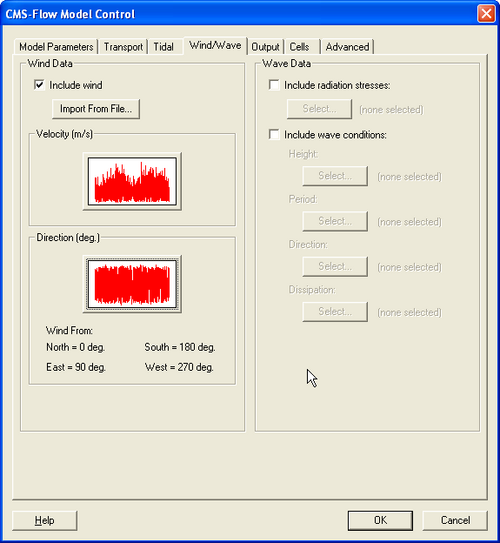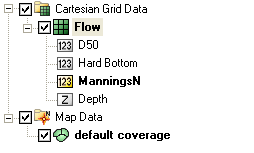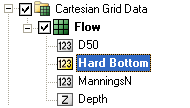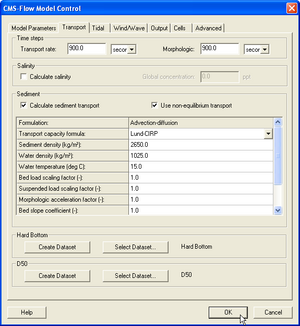CMS-Flow:Features
Global Forcing
There are two main types of global forcing available in CMS-Flow, wind and wave. Global forcing means that the forcing is applied on a cell-by-cell nature, rather than forcing along a boundary.
Wind Forcing
Wind Curve

Temporally varying, spatially constant winds are input in CMS in the Wind Section of the CMS-Flow Model Control Window. To add wind forcing to a current CMS-Flow project click on CMS-Flow | Model Control and then on the Wind/Wave tab. Activate wind forcing by clicking on the Include Wind check box. Winds may be imported using an *.m2w file or by specifying a curve for wind speed and direction. To specify a curve for each click on the respective box which says Curve undefined which will open the XY Series Editor. The time series may be manually entered, copied or imported from an *.xys file in the XY Series Editor.
Spatially Variable Wind and Atmospheric Pressure
CMS-Flow V4.0 and higher have the option to use spatially variable wind and atmospheric pressure forcing. Currently, this feature is specified in the advanced card section using the cards listed in the table below.
CMS-Flow cards related to wind
| Card | Arguments | Type |
|---|---|---|
| WIND_OUT_TIMES_LIST | Id number of output times list | integer |
| WIND_DRAG_COEFFICIENT | kappa in Hsu (1988) (default 0.4) | real |
| WIND_INPUT_CURVE | Name of model parameter file followed wind curve path | character |
| ANEMOMETER_HEIGHT | Height of wind speeds | meter |
| OCEANWEATHER_WIND_FILE | Name of Oceanweather, Inc. wind file (*.win) | character |
| OCEANWEATHER_PRES_FILE | Name of Oceanweather, Inc. pressure file (*.pre) | character |
| OCEANWEATHER_XY_FILE | Name of Oceanweather, Inc. coordinate file (*.xy) | character |
| WIND_PRESSURE_FLEET_FILE | Name of fleet wind and pressure file | character |
| WIND_PRESSURE_GRID_PARAM | Nwlat,Nwlon,wLatMax,wLonMin,wLatInc,wLonInc | integer and real |
| WIND_PRESSURE_TIME_INCREMENT | wTimeInc | real |
Wave Forcing
Temporally and spatially varying.
- Wave forcing is generally provided by the user selecting to use the Steering Module within SMS. The mapping of wave data from wave grid to flow grid is automated during the course of the steering process.
- If a choice is made not to use the steering process, the user must provide several datasets of information which has been mapped to the flow grid geometery.
- Radiation stress gradient
- Wave height
- Wave period
- Wave direction
- Wave dissipation
CMS-Flow cards related to wave forcing (one-way coupling)
| Card | Arguments | Type |
|---|---|---|
| WAVE_RSTRESS_DATASET | "File name" "Dataset path" | character |
| WAVE_HEIGHT_DATASET | "File name" "Dataset path" | character |
| WAVE_PERIOD_DATASET | "File name" "Dataset path" | character |
| WAVE_DIRECTION_DATASET | "File name" "Dataset path" | character |
| WAVE_DISSIPATION_DATASET | "File name" "Dataset path" | character |
Salinity Transport
In many estuaries, the density gradients caused by spatial variations in salinity can be an important driving force in the circulation. Salinity is also a key water quality variable in estuaries, since it affects the chemical and biological processes. Salinity is simulated in the Coastal Modeling System (CMS) in a depth-averaged sense. This means that the estuary or body of water is assumed to be well mixed vertically and the salinity is constant over the water column.
The salinity transport equation is solved with an explicit, finite volume method. The advection term is discretized with upwind scheme, and the diffusion term is discretized with the standard central difference scheme.
The CMS-Flow salinity cards are listed in the table below.
| Card | Arguments | Description | Versions |
|---|---|---|---|
| CALC_SALINITY | ON | OFF | Turns salinity on or off | >=v3.75 |
| SALT_OUT_TIMES_LIST | integer | Index of times list of output times | >=v3.75 |
| SALINITY_IC | real | Specifies the initial salinity value in ppt for the whole computational domain | >=v3.75 |
| SALINITY_IC_ASCII | character | Specifies the file name of a scatter set file (*.pts) containing the coordiantes and initial salinity values to be interpolated using the Laplacian interpolation | >=4.0 |
Additional information on Salinity Transport in CMS-Flow can be found here.
Other Processes
Bottom Friction

The bottom friction parameter (related to Manning ) is spatially varying (cell-specific) over the grid domain. The default value upon grid creation is 0.025. At times a user may desire to represent locations where added friction is needed due to structures or increased turbulence due to sharp changes in current speed. More information on using this feature of CMS-Flow can be found here.
| Card | Arguments | Default | Range | Description | Versions |
|---|---|---|---|---|---|
| USE_WALL_FRICTION | CHARACTER | ON | ON | OFF | Turns on or off wall friction | >=3.5 |
| MANNING_N_DATASET | CHARACTER CHARACTER | [<grid file>] [<grid name>//"Datasets/ManningsN"] | none | Grid file name and dataset path for the input Manning's n dataset | >=v3.5 |
| MANNING_N_CONSTANT | real number | none | 0.001-0.5 | Specifies input Manning n dataset | >=v3.5 |
| WAVE-CURRENT_MEAN_STRESS | character | W09 | W09 | DATA2 | DATA13 | F85 | HT95 | Defines the model used for calculating the mean bottom shear stress used in hydro | >=4.0 |
Hard Bottom

Hard Bottom is a morphologic constraint that provides the capability to simulate mixed bottom types within a single simulation. This cell-specific feature limits the erodibility of the constrained cells down to a specified depth below the water surface. More information on the use of hard bottom within the SMS can be found here.

Variable D50
When sediment transport and morphology change are activated, sometimes it may be desired to designate areas of the grid to have a certain grain size. This cell-specific parameter allows each cell to take on the characteristics of a certain sediment grain size. More information on the use of variable grain size (D50) can be found here.
Eddy Viscosity
Eddy Viscosity in CMS-Flow is not a user definable parameter. A description of the advanced cards related to eddy viscosity is shown in the table below.
| Card | Arguments | Default | Range | Description | Versions |
|---|---|---|---|---|---|
| TURBULENCE_MODEL | CHARACTER | SUBGRID | SUBGRID |FALCONER| PARABOLIC | MIXING-LENGTH | Specifies the turbulence model used | >=3.5 |
| EDDY_VISCOSITY_CONSTANT | REAL | 1.0E-6 | >=1.0E-6 | Constant contribution or base value of eddy viscosity | >=3.5 |
| EDDY_VISCOSITY_BOTTOM | REAL | 0.0667 | 0.01-0.2 | Coefficient related to the contribution to eddy viscosity from the bottom shear | >=3.5 |
| EDDY_VISCOSITY_HORIZONTAL | REAL | 0.4 | 0.2-0.6 | Coefficient related to the contribution to eddy viscosity from horizontal velocity gradients | >=3.5 |
| EDDY_VISCOSITY_WAVE | REAL | 0.5 | 0.2-1.0 | Coefficient related to the wave bottom friction contribution to eddy viscosity | >=4.0 |
| EDDY_VISCOSITY_BREAKING | REAL | 0.05 | 0.04-0.08 | Coefficient related to the wave breaking contribution to eddy viscosity | >=4.0 |
More information can be found here.
Other Features
Parallelization with OpenMP
Both Intel and AMD processors now are shipping chips with multiple cores/processors (henceforth referred to as "processors") available. CMS-Flow is now configured to make use of these extra processes that are available on newer machines.
Additional information on using Multiple Processors with CMS-Flow can be found here.
Advanced Output
The following advanced cards have been added to CMS v4.0 and higher for outputting additional output information, ASCII file output, and more.
| Card | Arguments | Description | Default value |
|---|---|---|---|
| XMDF_COMPRESSION | ON | OFF | Compresses the h5 file by a factor of about 7 | OFF |
| WAVE_OUT_TIMES_LIST | integer | Output time series id | 0 |
| EDDY_OUT_TIMES_LIST | integer | Output time series id | 0 |
| VISC_OUT_TIMES_LIST | integer | Output time series id | 0 |
| STRESS_OUT_TIMES_LIST | integer | Output time series id | 0 |
| BED_SHEAR_STRESS_OUT_TIMES_LIST | integer | Output time series id | 0 |
| GLOBAL_TECPLOT_FILES | ON | OFF | Outputs Tecplot ASCII files | OFF |
| GLOBAL_SUPER_FILES | ON | OFF | Outputs Tecplot ASCII files | OFF |
| GLOBAL_STATISTICS | [t0] [tn] [dt] | Calculates global statistics if specified | none |
| FLOW_STATISTICS | [t0] [tn] [dt] | Calculates flow statistics if specified | none |
| SEDIMENT_STATISTICS | [t0] [tn] [dt] | Calculates sediment statistics if specified | none |
| SALINITY_STATISTICS | [t0] [tn] [dt] | Calculates salinity statistics if specified | none |
Matrix solver
The four different solvers implemented in the implicit model are the Gauss-Seidel, Gauss-Seidel with Successive-Over-Relaxation, BICGSTAB, and GMRES. The same solver is applied to flow, sediment and salinity. The default solver is the GMRES. The solver may be changed using the advanced card in the table below.
| Card | Arguments | Description | Default value |
|---|---|---|---|
| SOLVER_TYPE | GAUSS-SEIDEL | GAUSS-SEIDEL-SOR | BICGSTAB | GMRES | Determines the numerical solver used | GMRES |
| HYDRO_MAX_ITER | integer | Maximum number of iterations (outer loop) for the hydrodynamics | 20 |
| SEDIMENT_MAX_ITER | integer | Maximum number of iterations (outer loop) for the sediment transport | 20 |
| SALINITY_MAX_ITER | integer | Maximum number of iterations (outer loop) for the salinity transport | 20 |
Advection scheme
As in the case of the solver, the same advection scheme is applied for the flow, sediment and salinity transport equations. There are three choices for advection schemes with upwinding in the implicit model: hybrid, exponential and HLPA. The hybrid scheme is fast but is the most diffusive. The exponential scheme is based on the 1D analytical solution to an advection-diffusion equation and produces very stable results. The HLPA is very stable and non-diffusive, but requires slightly more computational time. For most applications, the exponential scheme is recommended and is set as the default. The advection scheme may be change using the advanced card
| Card | Arguments | Description | Default value |
|---|---|---|---|
| ADVECTION_SCHEME | HYBRID | EXPONENTIAL | HLPA | Determines the advection scheme | EXPONENTIAL |
Units of Measurement
| Variable | Units | Symbol |
|---|---|---|
| Water Surface Elevation | meters | |
| Current Velocity | meters per second | |
| Flow Rate | cubic meters per second | |
| Salinity Concentration | parts per thousand | |
| Sediment Concentration | kilogram per meter cubed | |
| Sediment Transport | meter squared per second | |
| Bed Shear Stress | kilogram per meter per second squared |